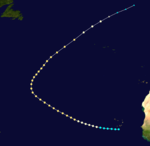1897 Atlantic hurricane season
| 1897 Atlantic hurricane season | |
|---|---|

Season summary map
|
|
| Seasonal boundaries | |
| First system formed | August 31, 1897 |
| Last system dissipated | October 29, 1897 |
| Strongest storm | |
| Name | "One" |
| • Maximum winds | 100 mph (155 km/h) (1-minute sustained) |
| • Lowest pressure | 972 mbar (hPa; 28.7 inHg) |
| Seasonal statistics | |
| Total depressions | 6 |
| Total storms | 6 |
| Hurricanes | 3 |
| Major hurricanes (Cat. 3+) |
0 |
| Total fatalities | 262 |
| Total damage | At least $150,000 (1897 USD) |
| Category 2 hurricane (SSHWS) | |
| Duration | August 31 – September 9 |
|---|---|
| Peak intensity | 100 mph (155 km/h) (1-min) ≤972 mbar (hPa) |
| Category 1 hurricane (SSHWS) | |
| Duration | September 10 – September 13 |
|---|---|
| Peak intensity | 85 mph (140 km/h) (1-min) 981 mbar (hPa) |
| Tropical storm (SSHWS) | |
| Duration | September 20 – September 25 |
|---|---|
| Peak intensity | 70 mph (110 km/h) (1-min) ≤1003 mbar (hPa) |
| Tropical storm (SSHWS) | |
| Duration | September 25 – September 29 |
|---|---|
| Peak intensity | 45 mph (75 km/h) (1-min) ≤1010 mbar (hPa) |
| Category 1 hurricane (SSHWS) | |
| Duration | October 9 – October 21 |
|---|---|
| Peak intensity | 80 mph (130 km/h) (1-min) ≤993 mbar (hPa) |
| Tropical storm (SSHWS) | |
| Duration | October 23 – October 29 |
|---|---|
| Peak intensity | 65 mph (100 km/h) (1-min) ≤993 mbar (hPa) |
The 1897 Atlantic hurricane season was an inactive season, featuring only six known tropical cyclones, four of which made landfall. There were three hurricanes, none of which strengthened into major hurricanes, which are Category 3 or higher on the modern-day Saffir–Simpson hurricane wind scale. The first system was initially observed south of Cape Verde on August 31, an unusually late date. The storm was the strongest of the season, peaking as a Category 2 hurricane with winds of 100 mph (155 km/h). While located well north of the Azores, rough seas by the storm sunk a ship, killing all 45 crewmen. A second storm was first spotted in the Straits of Florida on September 10. It strengthened into a hurricane and tracked northwestward across the Gulf of Mexico, striking Louisiana shortly before dissipating on September 13. This storm caused 29 deaths and $150,000 (1897 USD) in damage.
The third storm developed in the southeastern Gulf of Mexico on September 20. It tracked along the East Coast of the United States, causing widespread damage, particularly in Florida. A fourth storm was first observed in the northwestern Caribbean Sea on September 25. This storm moved in a semicircular path around Cuba and was last noted offshore Florida four days later. Minor wind and flood damage was reported in Cuba. On October 9, the fifth hurricane of the season was located near the Windward Islands. Moving westward, the storm eventually curved northeastward while crossing the Caribbean Sea, causing it to strike Cuba. Minor damage was reported on the island, though a ship sank with 230 people aboard; 42 of them were rescued, while the remaining 188 were presumed dead. The final observed system developed in the vicinity of the Bahamas on October 23. It later struck the Outer Banks of North Carolina; the storm caused severe flooding in southeastern Virginia, with six deaths reported. It was last noted on October 29.
...
Wikipedia











